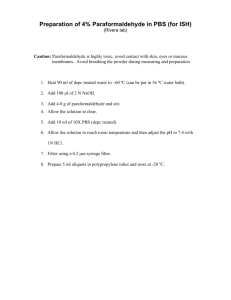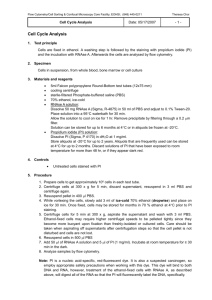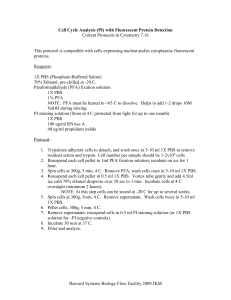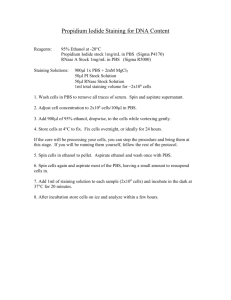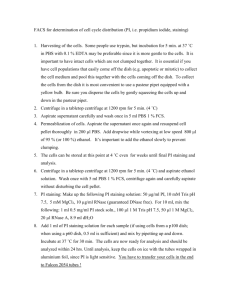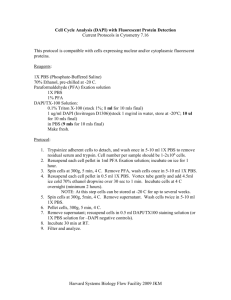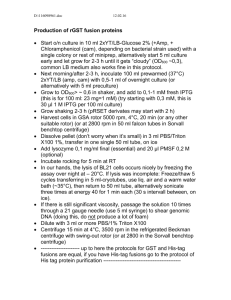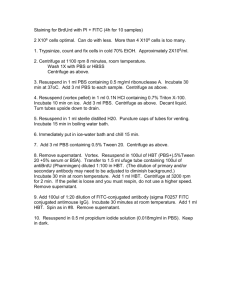Acridine Orange Staining Protocol
advertisement
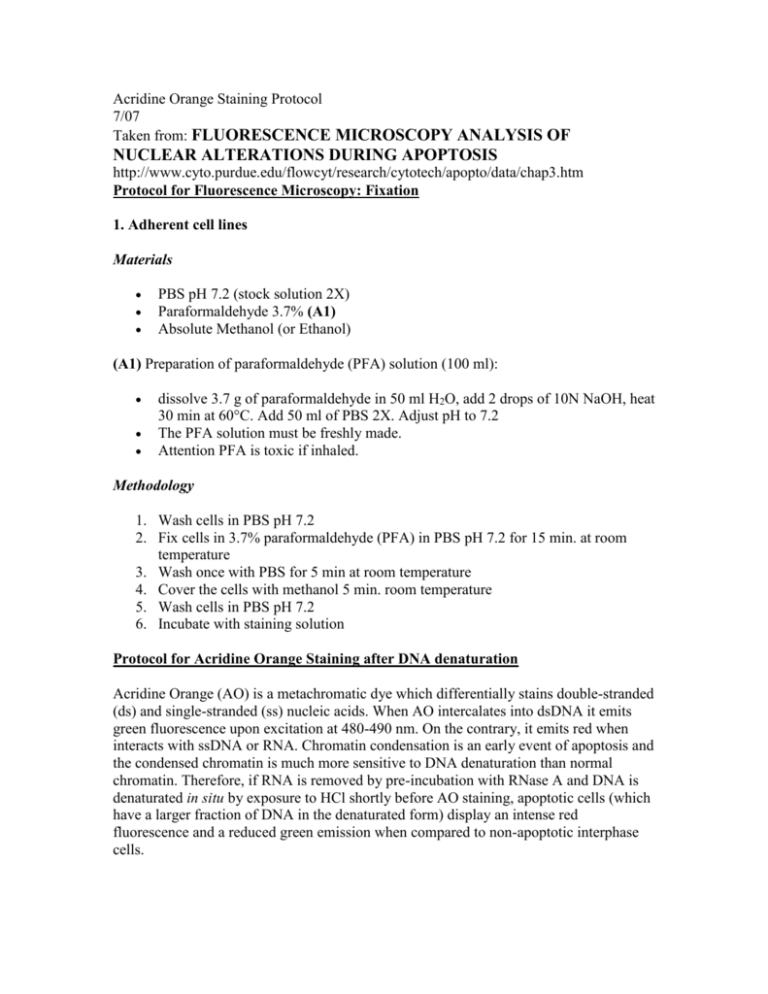
Acridine Orange Staining Protocol 7/07 Taken from: FLUORESCENCE MICROSCOPY ANALYSIS OF NUCLEAR ALTERATIONS DURING APOPTOSIS http://www.cyto.purdue.edu/flowcyt/research/cytotech/apopto/data/chap3.htm Protocol for Fluorescence Microscopy: Fixation 1. Adherent cell lines Materials PBS pH 7.2 (stock solution 2X) Paraformaldehyde 3.7% (A1) Absolute Methanol (or Ethanol) (A1) Preparation of paraformaldehyde (PFA) solution (100 ml): dissolve 3.7 g of paraformaldehyde in 50 ml H2O, add 2 drops of 10N NaOH, heat 30 min at 60°C. Add 50 ml of PBS 2X. Adjust pH to 7.2 The PFA solution must be freshly made. Attention PFA is toxic if inhaled. Methodology 1. Wash cells in PBS pH 7.2 2. Fix cells in 3.7% paraformaldehyde (PFA) in PBS pH 7.2 for 15 min. at room temperature 3. Wash once with PBS for 5 min at room temperature 4. Cover the cells with methanol 5 min. room temperature 5. Wash cells in PBS pH 7.2 6. Incubate with staining solution Protocol for Acridine Orange Staining after DNA denaturation Acridine Orange (AO) is a metachromatic dye which differentially stains double-stranded (ds) and single-stranded (ss) nucleic acids. When AO intercalates into dsDNA it emits green fluorescence upon excitation at 480-490 nm. On the contrary, it emits red when interacts with ssDNA or RNA. Chromatin condensation is an early event of apoptosis and the condensed chromatin is much more sensitive to DNA denaturation than normal chromatin. Therefore, if RNA is removed by pre-incubation with RNase A and DNA is denaturated in situ by exposure to HCl shortly before AO staining, apoptotic cells (which have a larger fraction of DNA in the denaturated form) display an intense red fluorescence and a reduced green emission when compared to non-apoptotic interphase cells. Materials Acridine Orange (A1) Citric acid Na2HPO4 Paraformaldehyde PBS DNAse-free RNAse A (A2) Ethanol HCl Equipment Epifluorescence microscope or Flow cytometer (A1) Staining solution Acridine Orange 6 g/ml Citric acid 0.1 M Na2HPO4 0.2 M pH 2.6 Prepare 90 ml of citric acid solution, add acridine orange and 10 ml Na2HPO4 * Acridine Orange solution is stable for several weeks when stored at 4°C and in the dark (A2) RNAse solution Dissolve 1 mg of RNAse A (use DNAse-free RNase) in 1 ml of distilled water Methodology: 1. Wash cells (1x106) in PBS and centrifuge at 200 g for 5 min 2. Resuspend the cell pellet in 1 ml PBS 3. Fix cells by transferring the cell suspension in 9 ml 1% paraformaldehyde in PBS, on ice. Incubate for 15 min on ice 4. Centrifuge at 200 g for 5 min and resuspend the cell pellet in 5 ml PBS, centrifuge 5. Suspend the cell pellet in 1 ml PBS and transfer the suspension in 9 ml 70% (vol/vol) ethanol, on ice. 6. Incubate for 4 h (The cells can be stored in ethanol for weeks) 7. Centrifuge at 200 g for 5 min and resuspend the cell pellet in 1 ml PBS 8. Add 0.2 ml of RNAse A solution. Incubate at 37°C for 30 min 9. Centrifuge at 200 g for 5 min and resuspend the cell pellet in 0.2 ml PBS 10. Add 0.5 ml of 0.1 M HCl at room temperature 11. After 30-45 sec add 2 ml AO staining solution 12. Observe the cells under fluorescence microscope with an appropriate filter set. 13. Alternatively, analyse cells by flow cytometry (excitation 488 nm; dot plot of green fluorescence at 530 20 nm versus red fluorescence >600 nm).
